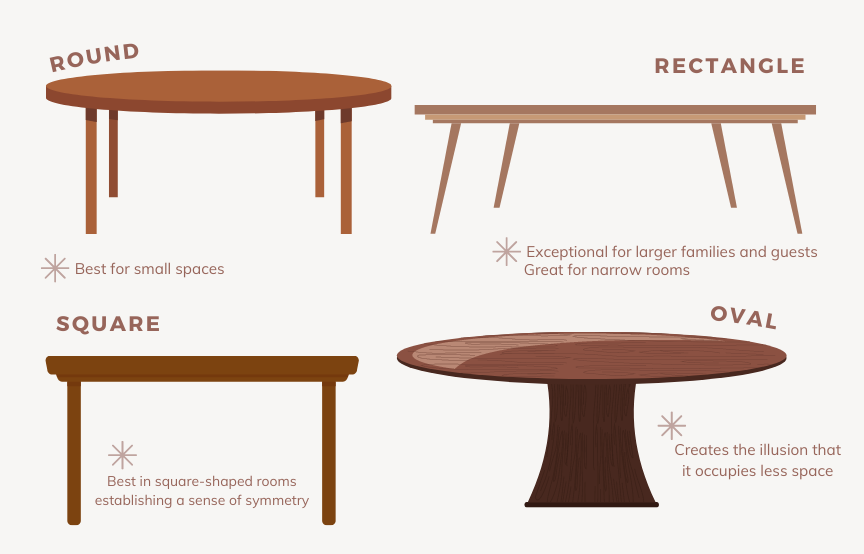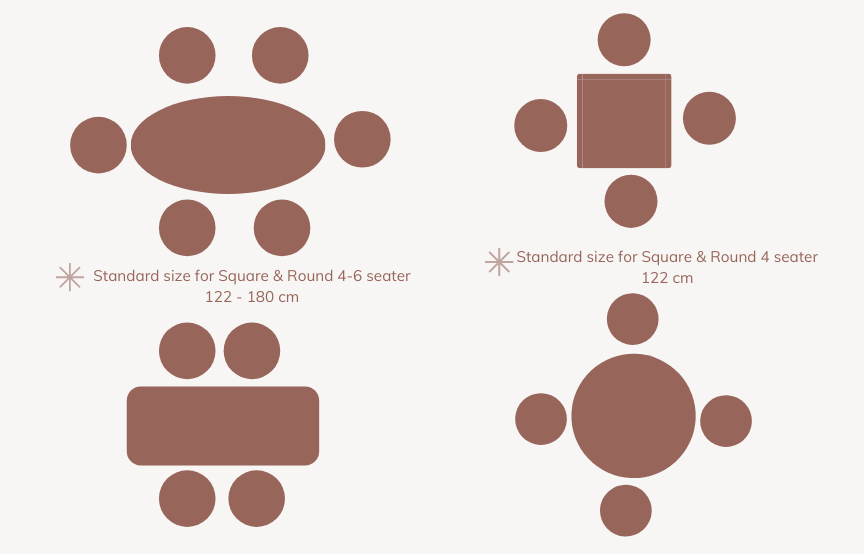How To Choose A Dining Table: Size, Shape & More
 by RJ Living |
May 7, 2021
by RJ Living |
May 7, 2021
From sharing meals with family to having friends over for a dinner party, our dining spaces are witness to many happy memories over the years. Choosing the right dining table that fits your style and needs lets you create the best room to utilize for you and your family.
In our guide to choosing the perfect dining table for you, we explore sizing, shapes, and the many factors involved in getting the right dining table. Scroll through and be inspired!
Narrow down your dining room style
.png)
One of the anchors of a dining space that works is its design. Always consider the overall design of your dining space. Do you have a specific colour or theme in mind? Which space will it go in, is it for a formal dining room or a casual breakfast nook? Just like a puzzle, it has to be the best piece of furniture for your needs and aesthetics. Let’s explore some popular dining table styles:
Industrial style dining table - If you enjoy the look of wood and metal together, then an industrial theme might be the best bet for you. Industrial style furniture dining tables are usually made of metal bases and wooden tops in a modern but rustic look. Expect to see wood grains, reclaimed wood, and natural features that highlight an organic look.
Scandinavian/Danish style dining table - This style of dining table is both practical and functional. Taking on the design elements of Scandi design in its simple, minimalist, and bright styles, Scandi dining tables are usually in light oak or white and showcase clean lines.
Modern dining table - Get the contemporary look with modern dining tables that will elevate your dining room. Featuring stark lines and sleek edges, these tables also highlight the best natural materials possible like Solid wood in oak. Modern dining tables also focus on the durability and timelessness of both material and design.
Choosing a dining table shape

When you’ve chosen down the style of your room, another step in choosing a dining room table is its use. Aside from mealtimes, will the whole dining area be for formal dinners or in a wide-open space near the kitchen? Placement and size of the room matters in choosing the right table for your home.
Round - round dining room tables are exceptional for smaller spaces. The rounded curves make it more compact plus it looks great in any type of interior style. They also make gatherings more intimate as everyone can easily converse with one another. However round dining tables aren’t best for larger gatherings as the shape can feel like you’re far away, and it’s harder to reach all your scrumptious food!
Oval - create an interesting look with an oval-shaped dining table. With its curved edges, it creates the illusion that it occupies less space, it also has a more traditional look than its round counterpart. This type of shape also gives a sense of intimacy, plus it can seat large groups of people.
Square - A square fitting inside a square, these dining tables look best in square-shaped rooms establishing a sense of symmetry. Usually seating up to 4 people, expandable versions can seat more guests. Also creating a sense of closeness, everyone at the table is within close proximity of conversation.
For larger groups, try setting up 2 square tables next to each other to make a bigger seating arrangement for guests during special occasions.
Rectangle - These dining tables are the most popular since most dining rooms are rectangular in shape. Exceptional for larger families and guests, this is best for those who like to entertain. Its linear shape makes it easy to have an extra leaf for more people and allows for easy navigation around the table. If possible, rectangular tables should be 91cm to 107cm across to ensure enough room for place settings on both sides of the table.
Always take into consideration that with rectangular dining tables and chairs added, it may take up a lot of room in your space. For a space-saving tip, use benches instead of dining chairs on one side of the table, which can easily be stowed underneath.
Standard dining table measurements

Choosing a dining table isn’t just about the size and shape, measurements ultimately matter as this will determine how your dining room will and your dining table will be utilised. It’s also important in the overall design and flow of the space. How big will the area be? Do you need a dining table size 8 seater? Dining table size for 6 seater? How many people will sit? Do you plan to entertain often?
Do keep in mind that in order to eat comfortably, a person must be spaced at about 61cm away from each other and that there should be enough table area for food and your gorgeous dinnerware collection.
Aside from measuring the room, when you’re settling on a dining table, consider these fundamental measurements:
| Table Shape | Table Size | Seating Capacity |
| Round or Square Table | 122 cm | 4 seater |
| 152 - 183 cm | 6 seater | |
| 137 - 183 cm | 8 seater | |
| Oval or Rectangular Table | 122 cm | 4 seater |
| 150 - 180 cm | 6 seater | |
| 140 - 200 cm | 8 seater | |
| 220 - 260 cm | 10 seater |
More tips in choosing a dining table size:
- Ideally, there should be 91 cm of table area to accommodate food and place settings.
- Create ample space to pull out chairs, sit comfortably and not feel too stuffy. Give at least 107 cm between the table edges and the wall.
- Always consider the whole room, especially other furniture in the space like sideboards and dining chairs. If you have a sideboard against a wall, measure 92 cm from that piece of furniture.
- An extension table is the key for a growing family or simply if you like to entertain. Always measure the table when it’s extended to make sure it fits your dining room.
Choose dining table by height
.png)
There are many dining table designs and shapes to choose from, however standard dining table height is pretty much the same across. Dining table height is important as people need to be able to sit comfortably and cross their legs. When a table is too tall, it gets uncomfortable to eat! The rule of thumb is that there should be at least 31 cm between the tabletop and the chair.
Standard: Standard height tables are about 73 cm to 78 cm high. This table is best paired with chairs that have seat heights of 44 to 48 cm. The standard height can work well with family and guests of different ages and mobility.
Counter: Counter-height tables are about 86 cm to 91 cm high and are best be used with chairs that have seat heights of 61 cm to 66 cm. Creating a more open look, this height works well in smaller spaces.
The right dining table materials and finishings for your style
.png)
You’ve chosen your style and figured out the measurements and size you need. For the fun part, we’ll take you through the many materials used for dining tables that’ll showcase your style and give you the dining space you’ve been wanting.
Solid Wood Dining Table - a classic option, solid wood is timeless and sturdy. Often creating a welcoming atmosphere, solid wood can be transformed into many styles and grain patterns. Solid Oak furniture is built to last. Choose a piece that will go over many interior styles for a truly perennial favourite. In maintaining a solid wood dining table’s coating and avoiding water stains, always check with the manufacturer or clean it with a mixture of vinegar, oil-water and a clean, soft cloth.
Glass Dining Table - A lot easier to maintain, cleaning glass is easy as pie, while also creating an elegant and open concept home. Giving a room the illusion of more space and light, glass works well with modern elements like stainless steel and brass.
Stone Dining Table - adding a dose of luxury and flair in a space, stones like granite and marble are a natural and classic option for a dining table. They’re durable and can withstand much use both indoors and outdoors. Although scratches may occur over time, some people think that it adds character to the piece. Stone tabletops are quite heavy and can work with smaller spaces.
Concrete Dining Table - a very durable surface material, concrete dining tables are easy to maintain and offer a modern yet rustic look to a space. Concrete dining tables often have a raw look so if you’re looking for something very polished, concrete adds more textures in the look and feel.
Veneer Dining Table - A durable and less porous surface for a dining table, Veneer dining tables have a covering that appears like solid wood, and is glued to particleboard or fiberboard. This type of material is very durable and its surface reacts better to spills and messes. It’s also considered to be environmentally friendly as thinner sheets of a log are used.
Extra tips on how to decorate a dining table
.png)
Once you’ve got all the essentials in hand, decorating your dining table will be a breeze. With a few touches and homewares, you can turn your dining room into a space that’s welcoming and cozy for mealtimes and dinner parties at home.
Here are a few design ideas on how to decorate a dining table when not in use:
- Create an accent wall with a pop of paint colour or interesting wall art.
- Place a rug underneath for more texture and added coziness. Take a look at our rug size guide here.
- Add a table runner or tablecloth that matches your style.
- Show off your place settings.
- Add in fresh flowers or dried ones in pretty homewares.
- Add an intimate look with candles and dim lighting.
No matter how small or large your space is, make meals and dinner celebrations more worthwhile with dining tables that fit your space. RJ Living’s range caters to both small and large spaces, as well as for growing families. Our team can also help in giving tips and ideas in how to style a dining table, too. We hope that this guide will help you and inspire you to create a dining room that works and is a beautiful place for laughter and great food.




